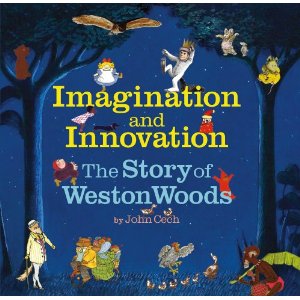Riddles and Weston Woods
 Sunday, May 2, 2010 at 07:32PM
Sunday, May 2, 2010 at 07:32PM Just wanted to note a few items. In the post on April 14, I added the answer Carroll gave in 1896 to the riddle of "Why is a raven like a writing-desk?"
Also, I am reading John Cech's brilliant new book Imagination and Innovation: The Story of Weston Woods  (Scholastic, 2009) in preparation for writing a review. It's a great study of a small company that consistently wanted to make film adaptations of children's picture books that stayed true to the books. Morton Schindel, the founder and guiding spirit of Weston Woods for the past 50 years, led a film studio devoted to making quality films for children through a process not driven primarily for profit or commercial motives. Cech shows how Weston Woods would use the emerging media of film and television to bring great literature to the lives of millions of children. In 1953, Schindel was one of the first people to adapt children's books into the film media. In contrast to Disney, Weston Woods films stayed true to the author's intentions, frequently using original illustrations. Schindel was "in fact, a pioneer in the filed of 'edutainment' (a word first coined by Schindel to describe the work of the studio)" (23). The book is richly illustrated and includes story boards of many of Weston Woods' famous adaptations including Maurice Sendak's Where the Wild Things Are (film adaptation: 1975). The animation for Wild Things was done by Gene Deitch, who was considered by Schindel to be the " 'unsung genuis of Weston Woods' " (68).
(Scholastic, 2009) in preparation for writing a review. It's a great study of a small company that consistently wanted to make film adaptations of children's picture books that stayed true to the books. Morton Schindel, the founder and guiding spirit of Weston Woods for the past 50 years, led a film studio devoted to making quality films for children through a process not driven primarily for profit or commercial motives. Cech shows how Weston Woods would use the emerging media of film and television to bring great literature to the lives of millions of children. In 1953, Schindel was one of the first people to adapt children's books into the film media. In contrast to Disney, Weston Woods films stayed true to the author's intentions, frequently using original illustrations. Schindel was "in fact, a pioneer in the filed of 'edutainment' (a word first coined by Schindel to describe the work of the studio)" (23). The book is richly illustrated and includes story boards of many of Weston Woods' famous adaptations including Maurice Sendak's Where the Wild Things Are (film adaptation: 1975). The animation for Wild Things was done by Gene Deitch, who was considered by Schindel to be the " 'unsung genuis of Weston Woods' " (68).
Cech explains how Schindel got his break in 1956 when Deitch, who was producing the Tom Terrific cartoons for Captain Kangaroo, was running behind schedule. Some of the first Weston Woods adaptations were shown on Captain Kangaroo's CBS morning television show for children. These included film adaptations of Robert McCloskey's Make Way for Ducklings and Andy and the Lion and Marcia Brown's Stone Soup. One film that was featured frequently was Wanda Gag's Millions of Cats.
As someone who grew up watching Captain Kangaroo and remembering these film adaptations, I found Cech's books a special pleasure. This is essential reading for anyone interested in children's media, which should be everyone interested in children's literature. John Cech established the importance of Weston Woods in a similar landmark books as Leonard Marcus' Golden Legacy does for Golden Books.

Reader Comments (1)
As my kids and I worked our way through the Weston Woods Childrens Circle videos at our public library (three cheers for Lincoln Library - The Public Library of Springfield, and our favorite librarian Classie), they turned us on to what would become many of our all-time favorite books and authors. I still can't read Tomi Ungerer without channeling the narrator voicing "THE THREE ROBBERS", and Carol King's soundtrack to Maurice Sendak's Really Rosie is still in heavy rotation on our various music players (cassette, cd and mp3).